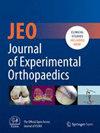Rapid and reliable alpha angle measurement using a smartphone-based artificial intelligence system for cam-type femoroacetabular impingement
Abstract
Purpose
Manual alpha angle measurement for diagnosing cam-type femoroacetabular impingement (FAI) is time-consuming and variable. We hypothesised that a smartphone-based artificial intelligence (AI) system would demonstrate a high correlation with the conventional manual method.
Methods
We trained an AI model using 300 of the 45° Dunn view radiographs in a Python-based environment. The model was implemented using a smartphone application that semi-automatically extracted the femoral head from radiographs, detected at least four rim points, and calculated the femoral head centre and radius using a least-squares method. It also identified the narrowest part of the femoral neck, and allowed manual adjustment of the alpha angle deviation. The images were directly captured and transferred without time loss. We evaluated 130 hips of patients with hip pain who underwent 45° Dunn view radiography. The alpha angle was measured using both the AI system and the manual method. Pearson correlation coefficient was used to assess agreement between the two methods. Measurement time and intra- and interobserver reliability were assessed using intraclass correlation coefficients (ICC).
Results
Pearson correlation coefficient for alpha angle measurement between the two methods was 0.91, indicating a strong correlation. The average alpha angle measured by the AI system (52.7 ± 6.0°) was not significantly different from that of the conventional method (53.9 ± 6.5°, p = 0.12). The AI-powered system showed intra- and interobserver agreement ICCs of 0.96 and 0.93, respectively, demonstrating excellent reliability. The mean measurement time was 5.0 ± 2.4 and 46.7 ± 10.1 s for the AI-powered system and manual method, respectively, indicating significant time-saving.
Conclusion
The AI-powered system showed a strong correlation with the manual method and significantly reduced measurement time. This smartphone-based tool offers a rapid and reliable approach for real-time assessment of alpha angles and may help standardise the evaluation of cam-type FAI in clinical practice.
Level of Evidence
Level III, retrospective comparative study.





 求助内容:
求助内容: 应助结果提醒方式:
应助结果提醒方式:


